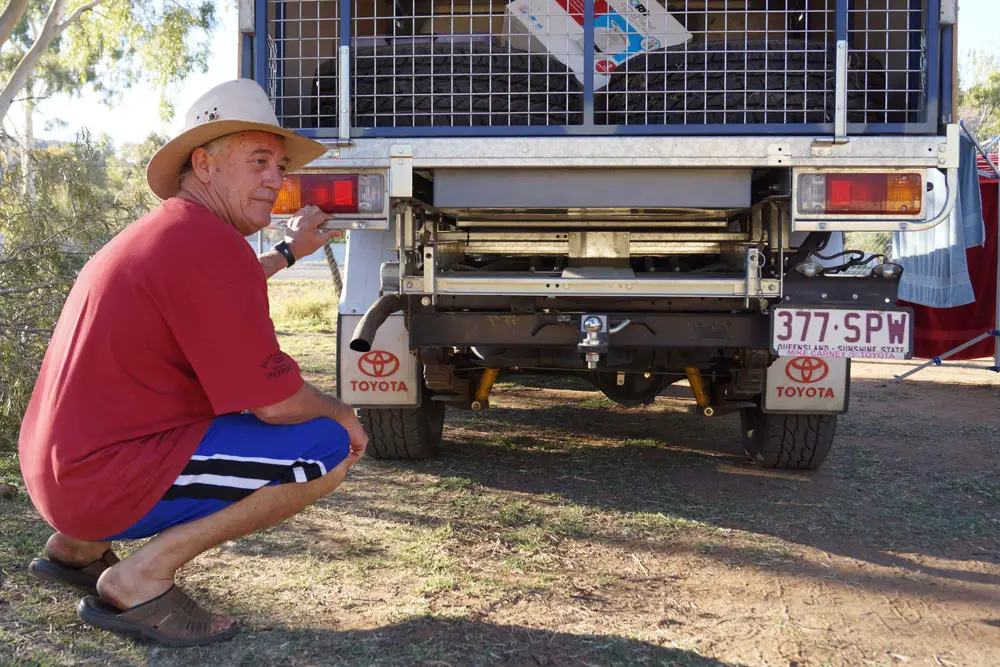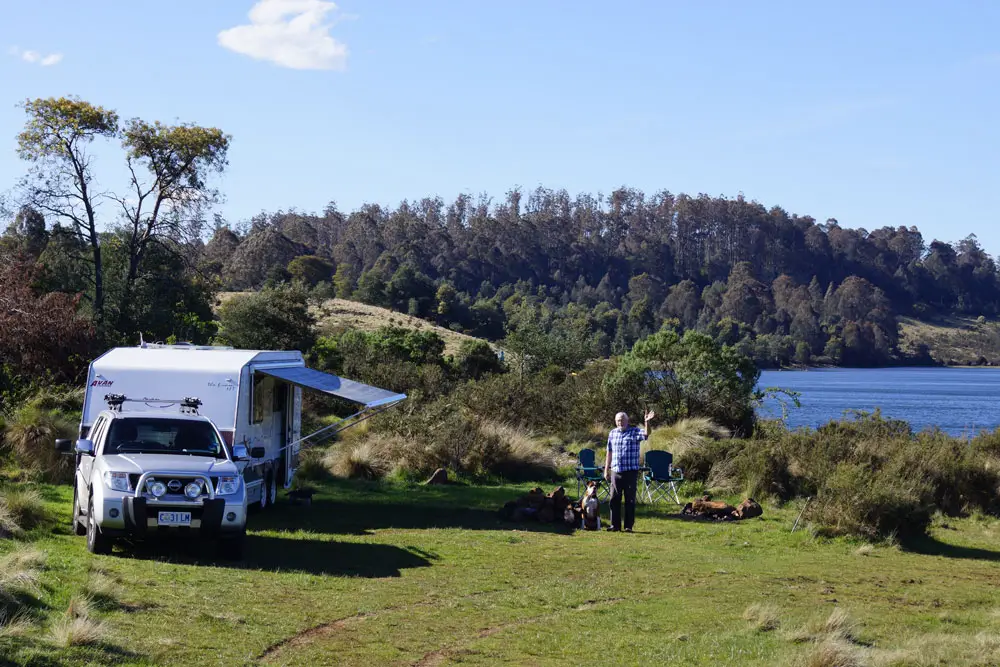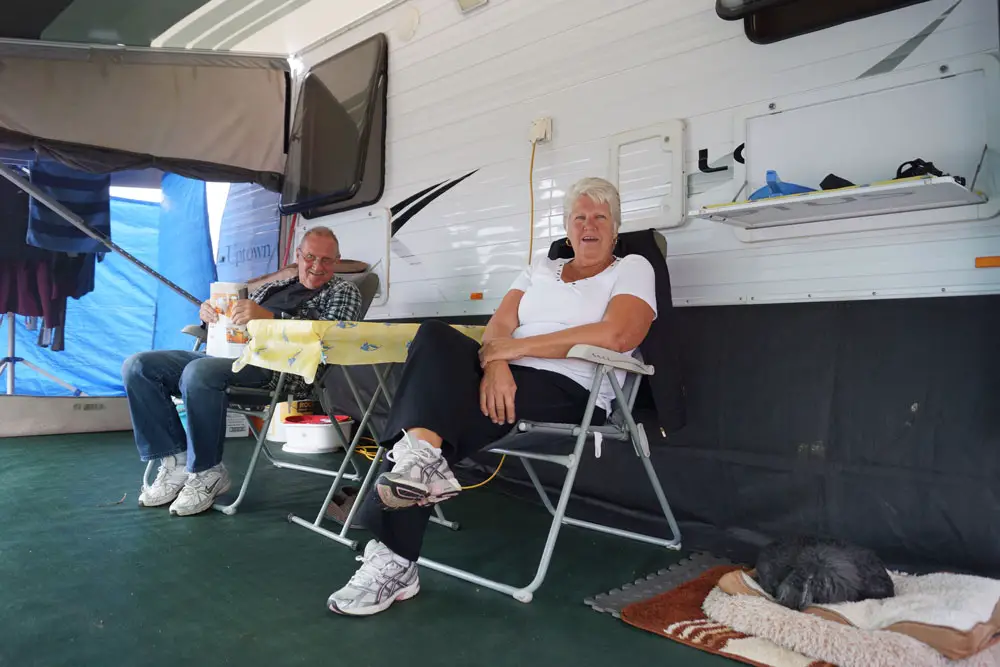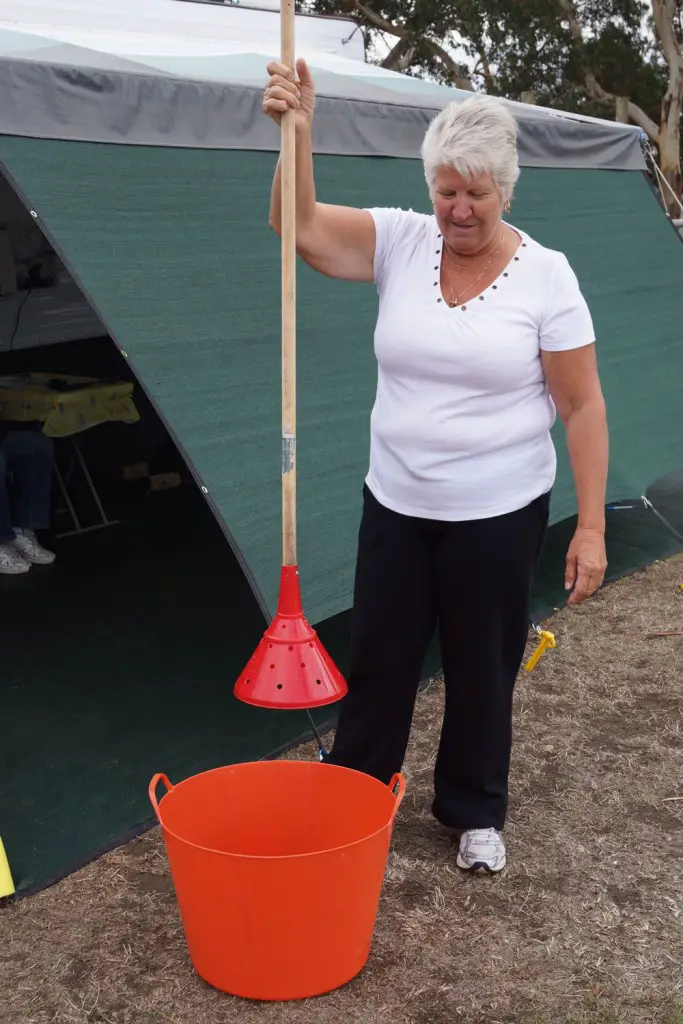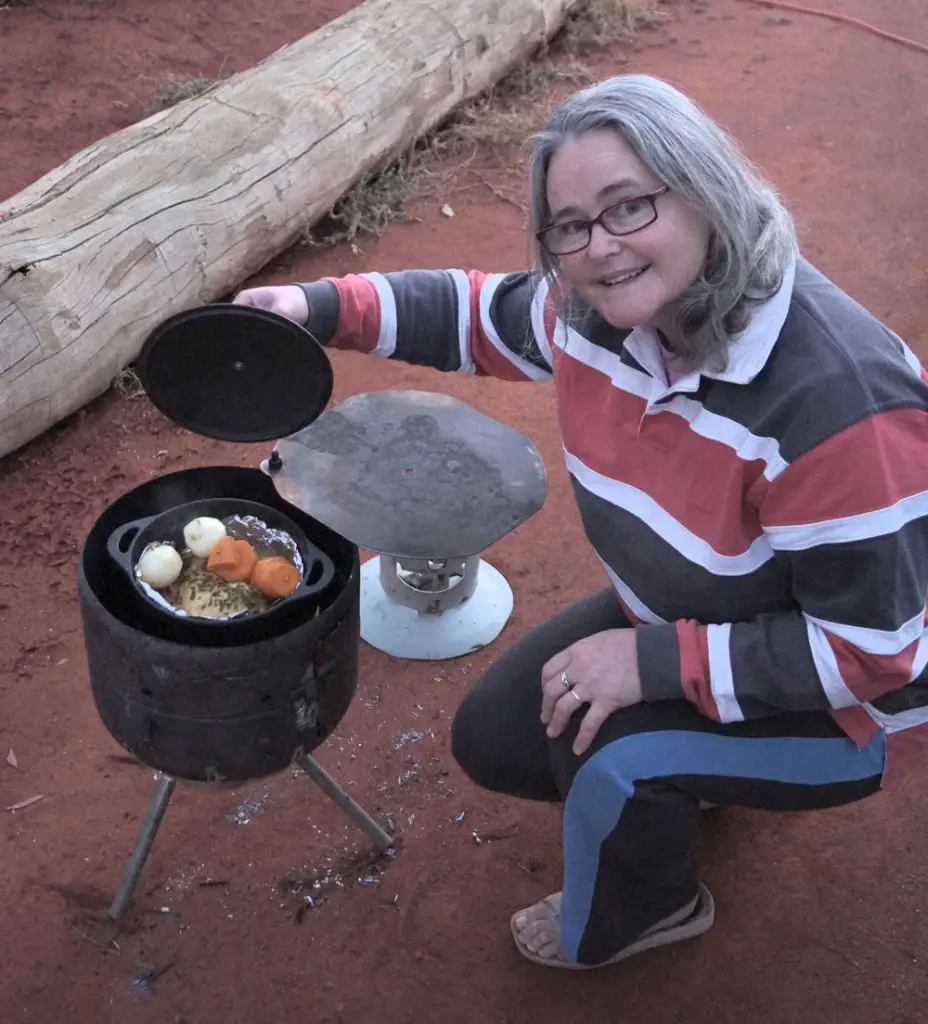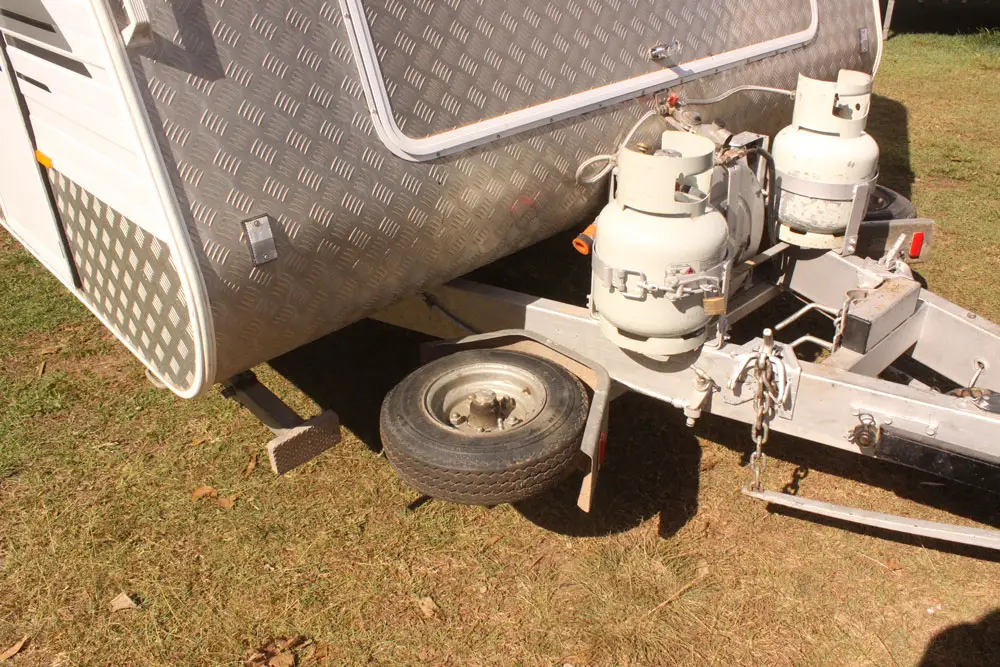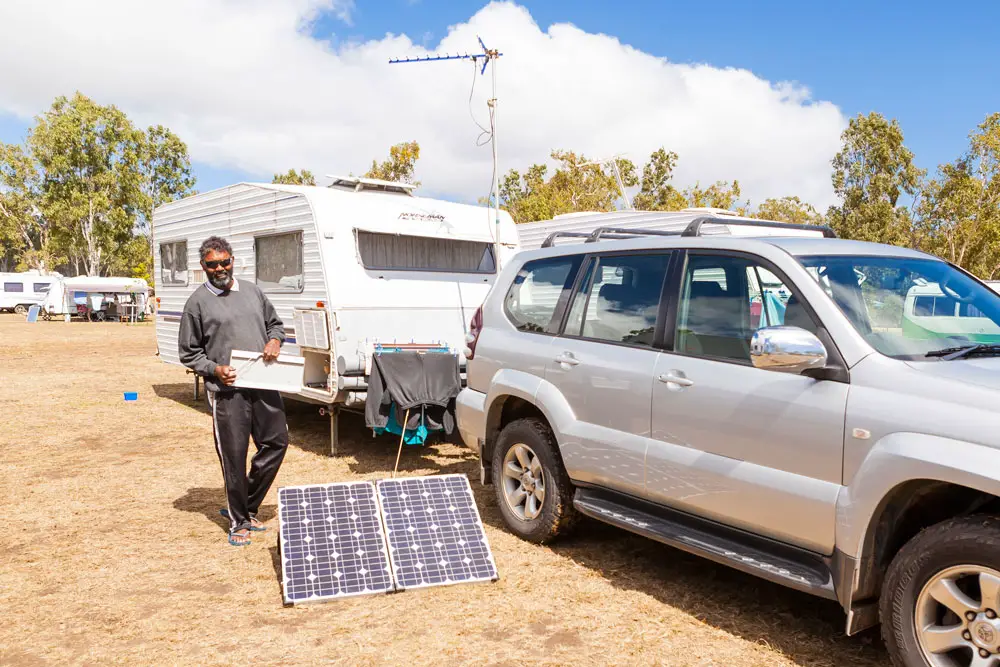The Great Escape
Words and photography by Ray and Trina Morris
The ultimate travel experience is having the freedom to explore stunningly beautiful places, uninhibited by those umbilical cords of power cables, water hoses – and everything they represent. The undeniable pleasures of travelling unplugged reveal the raw reality of a free camping destination – because you are truly amongst it! Fish jump at your camp chair, waves roll up the sand and lull you to sleep, nocturnal wildlife captivate you as they bicker beyond your campfire, the smell of wildflowers all around your campsite flavour your morning cup of tea, and the colours of desert sunsets on granite tors towering over your rig reflect prettily on your wineglass at happy hour. Ahh… and the beauty and solitude of it all!
Free camping provides a special sense of satisfaction and a feeling of independence. It also cultivates a deep kindred spirit with those around you, through instant, yet genuine, friendships with fellow nomads. This is true with all touring, but somehow it is intensified when camping in remote places. Free camping is the purest, ultimate escape, so it’s time to scheme your breakout.
PREPARATION AND PLANNING
I can barely remember the five Ps I learnt at Guides – something like: Perfect Planning and Preparation Prevents Problems… or something like that. This is relevant to free camping, but so is the ability to be flexible and the need to compromise. It’s not just a matter of cramming your rig full of every imaginable item you could possibly want – it’s about neatly fitting your rig out with only the things you absolutely need! And I’m here to tell you, from practical experience, that there is a major difference between the two!
Preparing the Rig
Firstly, you need to plan what rig is perfect for the type of touring you intend to do. Many nomads have to reinvest in sturdier units once they realise they prefer free camping over staying in van parks, and discover their rigs just aren’t cut out for the extra demands of free camping. In the monopoly game of investment choices, a common example of escapees coming unstuck and being sent back to gaol (do not pass Go, do not collect $200) include buying huge luxurious units offering (energy hungry) modern appliances, but little in the way of independence for remote living. For example, big units with far too much bulk to easily manoeuvre into free camp spaces; RVs without self sufficiency in energy generation and water storage; importehttps://www.candm.com.au/files/d rvs that are not built for our rugged outback australian road conditions; or tugs that do not have the towing capacity for the caravan purchased, despite meeting legal tow/weight requirements.
On this last point, we made a (very expensive) mistake as novices. With a limited budget, we bought a small caravan with everything we knew we needed for free camping, even though it lacked some things we wanted (such as separate shower/toilet, washing machine, full off-road capability etc). We were careful to ensure the GTM (gross trailer mass) was within the legal towing capacity of our almost new medium-sized SUV’s GCM (gross combined mass) requirements. But it only took a weekend test trip to reveal we had underestimated our manual tug’s gearing. Without low range, it could not pull the van up a moderate slope from a stationary position without us badly riding the clutch to get the revs up enough for the turbo to cut in. After nearly burning the clutch out trying to manoeuvre the van into a moderately difficult position, one typically encountered when free camping (versus easily accessible, flat caravan park sites), we knew we were in trouble. A trip to the big city car dealerships ensued, and after a very expensive trade-up to a bigger 4WD with low range, a more powerful motor and much bigger towing capacity, we had a tow vehicle which allowed us full free camping capability with our 19 foot caravan.
The lesson here is to establish what your budget is and then talk to lots of experienced RVers, read C&M reviews, online forums, and look beyond the salesmanship rhetoric of RV manufacturers to establish exactly what rig – tow vehicle and caravan combination – is right for your particular travel dreams. Once you have the right rig, maintain a rigorous maintenance programme: motor, tyres, pumps, filters, frames, electrics, gas systems, tanks – everything must be kept in tip top shape to ensure safety, legal obligations, longevity and hassle-free touring.
Planning your trip
Trip planning is not only an important aspect of free camping, but a very enjoyable one. Two essential aids in planning and completing a free camping adventure are talking to, and reading about, veteran free campers, and having a good camping guide along for the ride. The best of these is generally considered to be the Camps Australiawide manual, now up to edition 7. This is the nomad’s ‘bible’ and there aren’t too many happy hour events without one of these comprehensive camping destination guides on a lap at the campfire, or tow vehicles without one stashed within easy reach on the dashboard or in the door pocket.
Deliberate over where you wish to travel, and be sure to do it at an appropriate time of year. Travelling north during the wet season is unwise, as is travelling into central Australia during summer, or across the snowy mountains during winter. Fire, floods, snow and ice are all hazards to consider when entering a region, so it is important to plan a journey carefully, and to keep in touch with local road and weather conditions, to ensure your best laid plans are not thwarted by mother nature.
We were travelling in northern WA in July, camping beside the massive, but dormant, De Grey River. This is one of the state’s most significant waterways, and in the wet season it becomes a flooded torrent. Being the dry season, we, along with about fifty other free campers, didn’t give the concept of a flash flood a thought. The day after we left, an uncharacteristic and record-breaking rain depression swept through the region, creating a dangerous, mad scramble by dozens of RVs to safer high ground. Almost everyone made it out with their rigs intact, but one devastated couple had to be rescued after their motorhome was tipped over by the raging flash flood.
So, when free camping, never be complacent: read all campsite signs (which, in this case, warned of exactly such an occurrence but which we all blithely ignored), and remain vigilant, especially if camped near a watercourse during rain, or in dry country during conditions of high fire danger.
Take care to plan your route with a relaxed lifestyle in mind – many novice nomads (yes, we’re guilty of this, too) plan impossible itineraries and try to cover too many destinations in one trip, with too many kilometres in between. Be assured: Australia isn’t going anywhere! All those amazing places will still be there next time round, so don’t cram too much in on your first (or twenty first) odyssey. We made this mistake on our inaugural adventure, and became exhausted, feeling the pressures of deadlines and dates on lists of paper… even though we thought we had deliberately planned against exactly this eventuality!
We travelled through inland and outback Queensland as if a tornado was on our tail, tackling far too many kilometres in a day, leaving little time to explore and no time to relax, frequently arriving too late to get a good camp site (or any campsite at all, in the popular places). This intensity is dangerous to health and relationships, and is not conducive to good driving or happy camping. Thank goodness we are best buddies and great communicators, and were able to analyse our way out of our muddle! Advice from Max, a lovely gentleman we shared a campfire with at Coominglah Range near Biloela, hit home – he said he never drives more than 150 kilometres a day. We were doing two and three times that, so he left us speechless… but thinking hard. Good advice, indeed, Max!
We will never make that blunder again. On our current journey around the Big Lap, we are deliberately leaving out fantastic destinations, including Darwin and Kakadu, coastal Queensland, SA’s Eyre and York peninsulas and south west WA, which we can now look forward to on future adventures. I bet some of you are thinking: “They left all that out? What did they see, then?” but I can assure you, we are having an absolutely wonderful time exploring gorgeous out of the way places, and taking lots of time to do it.
WHAT TO TAKE
Some people find that free camping is an acquired taste, but we think of it as an acquired art! Having a clear concept of what to take – and what to leave behind – can make or break a free camping adventure, and this comes with experience. On our first trip we took everything. On our second trip we realised our mistake and, at great expense, posted home large heavy items, including our 15-bar espresso coffee machine and a convection microwave oven, both of which were totally unsuited to free camping because they required huge amounts of power. What were we thinking? Clearly, we weren’t!
We don’t have to go without, though. We simply replaced them with smaller units that are well suited to free camping. Our new coffee machine, a ROK Espresso Maker, is the most brilliant invention on the planet for coffee-loving free campers, as it requires no electricity whatsoever, yet makes a fabulous espresso. We also bought a tiny microwave which does everything, including my chocolate fudge slice baking, and it runs easily on our free camping energy system. A whisk and potato masher are perfectly good replacements for the blender I sent home, and who needs a hair dryer on a camping adventure? The lesson is: be lean and mean on your choice of accessories.
Lifestyle Essentials
Lifestyle equipment is a personal thing, and an important consideration when free camping. Truly experiencing a destination involves spending as much time as possible living outdoors. Comfortable, compact, lightweight and practical outdoor lifestyle accessories are, therefore, essential items to include on your ‘need’ list. Deep padded chairs, foot stools, a small collapsible table on which to rest happy hour goodies, and a raised bed for your pooch, are standard necessities.
One invaluable lifestyle item for providing outdoor living flexibility and enjoyment is the roll-out awning, since they almost double the rig’s living space. Most units come with an awning as standard, or they’re offered as an optional extra, and they can be retro-fitted onto many older vans. Awnings provide shelter, shade and privacy for living, gear storage and outdoor entertaining. Most have anti-flap systems and shade screens as optional extras, and can be morphed into annexes with ease. Awnings do require TLC to prevent damage in wind and rain, so be sure to maintain a strict program of tying down both corners to ensure wind doesn’t carry it away, and sloping the awning to prevent pooling water from causing it to collapse.
Beyond that, we get into ‘want versus need’ territory. We once thought ground matting under the awning was an optional extra – a want, rather than a need. But, over time, we have come to appreciate the advantages matting provides, so we no longer begrudge the weight and bulk of this camp item. It doesn’t matter if our camp site is putting green-smooth or a pebbly, prickly, tangle of long weeds, our ground mat turns every camp into a home. As a result, our outdoor living is more pleasurable, flexible and our caravan is much cleaner. A quick sweep with a broom leaves our outdoor living space clean, tidy and a pleasure to occupy.
SELF SUFFICIENCY IS CRUCIAL
A free camping van or motorhome must be well set up for self sufficiency. This involves solar panels, batteries, 12 volt wiring and LED light bulbs, 12V appliances such as TV, radio and (three-way) fridge, gas and wood cooking systems, and large storage capacity. A shower and toilet, in some shape or form, is necessary, and large water carrying capacity is absolutely vital.
This is all expensive stuff, both in cost and space, so self-sufficiency often takes a back seat when nomads skimp and save. This is fine if planning to stay in powered sites in parks, but not if freedom is the goal! If in doubt about such a significant initial outlay, simply compare the one-off cost of becoming fully self sufficient to the expense of paying for powered park sites forever, and you will find you’ll be well in front financially (and psychologically!) through self-sufficient free camping.
Power
The first consideration in self sufficiency is energy production. We prefer the purer form when free camping – solar power. Yes, we carry a generator, but only as a back up and we use it thoughtfully. When planning your power needs, it is helpful to go through your appliances to establish what load they place on your system: for example, laptop computers and anything that involves heating/cooling have high power demands.
Assuming you restrict your energy needs to a sensible minimum, a good solar set-up involves a minimum of two 100-120W solar panels on the roof and two 120A heavy duty deep cycle batteries in the rig to store the power. An excellent alternative to roof panels are portable fold-out solar panels, as these can be placed in the sun, enabling you park the rig in the shade. They also allow for easier regular cleaning, which is essential for solar panels to work efficiently. Many RVers invest in both, which means the portable panels can provide additional power generation in the event of cloud or rainy periods. They are handy to boost the car battery when operating a portable fridge/freezer in the wagon or an inverter to charge phone, computer and camera batteries in the car.
Another important factor regarding the power set up in a free camping rig is that most RVs come with a fairly basic battery charger. Consider investing in a more powerful unit to significantly increase the charge into your battery from your solar panels, car, generator or mains power. This is critical when relying on solar generation.
An Anderson plug is a great addition to any tow vehicle. It allows the car’s alternator to charge the RV batteries while travelling, which is the most efficient way to run the RVs fridge. Most rigs have an Anderson plug these days, but some RVers may not realise that, for twice the price, they come with an automatic isolator. This prevents the need to detach the Anderson plug when the car is switched off so the fridge doesn’t drain the car battery.
Gas
Most RVs are fitted with two gas bottles, ideally, the larger 9kg size for remote camping and cheaper refills. Our smaller van only has two 4kg gas bottles, so we have developed very efficient gas saving habits, and we also carry an additional gas bottle (always upright!) for longer-term remote camping flexibility, and to run the BBQ or external gas burner. We save gas by keeping burners turned low, using lids on pots, turning the fridge over to 240v when generator is running, and routinely cooking outdoors on our pig fire box.
Never leave the gas turned on to run the fridge when driving – this is illegal and dangerous. A great tip Aaron from Townsville gave us is to immediately install a gas bottle whenever you swap or refill it to check for leaks before you leave the supplier. If you can smell the stenching agent (gas is odourless), take it straight back in for inspection or replacement.
We prefer refills to ‘swap and go’ replacement bottles, for three reasons: we found out the hard way that our gas bottle holders on our A-frame only take one of the three sizes of 4kg bottles in the swap system; because the swap and go bottles are not always full; and because refills are much cheaper than the swap bottles.
Water
A large water carrying capacity is essential when free camping, since water is the commodity we most often run out of. Observing good water-saving routines is very important. We’ve spoken to RVers all over Australia about water-saving tips, and one of the most extreme examples we’ve heard came from Roy and Bev from Caboolture, who bathe in creeks, rivers, lakes and springs whenever possible, and when not, they spray each other with a water misting bottle to ‘shower’! Roy was justifiably proud to report they can go for four weeks in a remote area on only 120 litres of water – incredible! They travel in a very small motorhome without a shower and toilet, since they believe these ‘luxuries’ are the greatest wasters of water on the road! When there are no toilets at their free camp, they use a porta-potty in an ensuite tent.
We are not quite that dedicated! We love our combined shower/toilet, which makes free camping comfortable, but we are always extremely frugal with our water – a good habit we’ve developed, even when not strictly necessary. Like many nomads, we carry extra water in large bottles, but these are bulky to store, raise the rig’s centre of gravity, and are very heavy to handle. Jan, from Frankston in VIC, has a simple solution to this: she switched her extra water bottles from two 15 litre to six five litre bottles which are more convenient to tuck into neat spaces and she can handle with ease.
Gordon and Collette, from Perth WA, have installed a water retrieval system which filters and purifies water from creeks, lakes or rivers. They use it purely for showering and washing, saving their precious freshwater for drinking only. A perfect free camping tip!
Grey water storage is a much-neglected aspect of free camping by RVers. Many free camps are signposted ‘for fully self-contained vehicles only’ and this requirement means our grey water must be collected and stored, for later disposal into a dump point. Catching grey water in buckets is not acceptable and unfortunately we’ve seen plenty of rigs discharging grey water directly onto the ground at these camps, which could threaten closure.
We recommend investing in a rig which comes with extra freshwater and grey water storage capacity. Freshwater storage is usually easily expanded with an extra tank fitted under the rig, but this often compromises the ability to add yet another tank for grey water storage. Some canny RVers have self-installed stormwater pipe systems for collection of grey water under their vans – very inventive! A similar clever innovation is the addition of 40mm PVC pipes under the van to store those mucky grey water waste hoses, which, when rolled, can take up an enormous amount of space in the boot.
Heating and cooling
Reverse cycle air conditioning systems have high power demands and should be saved for mains power or, in exceptional circumstances, can be run off a generator. But air con is definitely a luxury when free camping – a want, not a need!
There are very effective 12v fans and rechargeable air coolers on the market to beat the summer heat and you can set your rig up with plenty of shade screens to cool it from the outside by installing sail tracks. If you feel the cold, a diesel heater will keep the rig warm when travelling in winter, but these units don’t come cheap. Alternatively, use the heat from cooking to warm the van and then climb under the covers to read when it’s chilly inside.
The other option is to toughen up! This is a favourite saying of ours, now. As residents of Hobart, our recent trip through the top end and central Australia during the hottest winter in years was challenging at times. We very nearly resorted to running the air con during a string of intensely hot days accompanied by 90% humidity. But a war cry of “toughen up!” was enough to stop the self pity and helped us reach for cool drinks and to turn up our evaporative rechargeable cooler fan one more notch.
Cooking and Refrigeration
Outdoor cooking is one of the major pleasures associated with free camping. There’s nothing like an open fire complete with a camp oven or cooking tripod to make any meal an experience, but there are many more efficient options available. Our pig fire box is one of our favourite possessions and I will remain forever indebted to Eddie for creating it out of an old gas bottle for us. It is neat and not too heavy, requires very little wood and operates efficiently on BBQ beads. It fries, bakes, roasts, grills and BBQs our food to perfection with minimal fuss and virtually no cleanup. We love it!
To supply it, we carry a tiny chainsaw for when we can’t collect wood off the ground, but we never operate the chainsaw in camp grounds. If you think generators create friction, stand back and watch the fun when someone revs up a chainsaw during happy hour! The best option is to cut a little wood at suitable places by the roadside before you reach camp. When a fireban is declared, or fires are not allowed, heat beads can be used in a pig fire box like any other BBQ.
Portable gas BBQs are very popular, particularly those with roasting lids, and good RV units come with slide out gas cookers as standard. One of the more simple outdoor cookers I’ve seen was the combination of a tripod hotplate slung over a single gas burner: neat, compact and effective. John and Marg from WA relaxed in comfy camp chairs at Newman and chatted to me while cooking up a feast on their little hotplate.
One aspect of free camping that can make life challenging is keeping food fresh. Food is bulky and weighs quite a bit (as we know from lugging it out of the supermarket), and some of it needs to be kept cold, so travelling with a large amount can be difficult. Yet remote long-stay free camping requires a good store. Relying on non-fresh staples like rice and pasta can bulk out a meal, but if you prefer fresh food, invest in a large capacity RV fridge. Our 75 litre fridge with separate freezer is great, but only just serves our needs for a two week remote stay. Many free campers have additional portable fridge/freezers to help them stay out for longer, but these place heavy demands on energy production, are bulky to carry and pricey – a decent portable unit with good features will set you back around $1000.
Storage
Plenty of storage space is required to fit all the extras required for freecamping, which are often heavy and bulky items. Be very careful not to overload the van! This risky endeavour voids your insurance and causes serious accidents. Give plenty of thought to what, where and how items are stored, considering weight, bulk, accessibility, and safety (e.g. fuels).
For example, never overload the rear of the van, especially the rear bumper. Turning this into a rack for half your gear is asking for trouble. Heavy items should be stored low down over the wheels, medium items above and immediately beside that area, and only light items at head height or at the extreme forward and rear sections.
State regulations also vary on how hazardous items can be carried: some prohibit flammable liquids (fuel jerry cans) to be carried on the rear bumper, which is a favourite storage space on many rigs. Incidentally, some states require ‘Do Not Overtake Turning Vehicle’ stickers to be affixed to the rear of rigs over a certain length, which applies to most caravans under tow, so it’s a good idea to check the road regulations of each state in which you plan to travel.
Safety and Security
Some RVers are wary of free camping because they fear being unsafe in remote places, but this certainly hasn’t been our experience. Safety and security requires common sense, such as choosing clean and tidy camp grounds, which indicate they are not frequented by riff raff, and staying in camps with other RVers onsite, since we all look out for each other. Getting to know your neighbours is both wise and enjoyable, and keeping your wits about you can prevent nuisances or danger. A spare door key kept separate from the rest (many sling it on a lanyard around the neck) is a great tip, and storing valuables out of site is a security fundamental.
Remote touring means you may be the only folk around for hours at a time. If a breakdown occurs, it is good to know you can communicate with someone. Since mobile phones don’t cut it outside major regional centres, having a UHF radio on board can be a valuable safety item. It enables you to communicate when in trouble, or to plan a safer trip by getting up-to-date road conditions from other travellers.
Rig security is always an issue and, sadly, there have been a few reports of items going missing from parked rigs in free camps and caravan parks. We’ve even heard one anecdote of an entire caravan being taken from a remote camp when left unattended and unsecured. The days of leaving valuable items outside when off exploring are over, and most RVers will only leave a camp chair unattended these days. While many RVers will look after a nearby rig for absent neighbours, this is not always possible.
We lock our caravan tow hitch, but we know this does little more than prevent an opportunistic thief. Dedicated and well equipped criminals can cut any security item off a rig in minutes, but we don’t intend to make it easy for them! Wheel clamps are a much more effective method of security, but they are heavy and bulky, so we prefer the ball hitch lock and we complicate it by padlocking our heavy tow hitch chains around it. We have padlocks on our spare wheel, tool boxes and pig fire box, cable locks to prevent quick thefts of gas bottles, bicycles and solar panels, and we have a very sturdy cable lock on the generator when it’s out.
It is important to ensure your tow vehicle and your RV are locked at night. Surprisingly, the worst accounts we’ve heard of RVers confronting thieves have occurred in caravan parks, not in free camps. Nomad friends were awoken by their van rocking and hearing voices. Brave male investigated and found two men ransacking his gear under the (unlockable) tourneau cover of his utility. He chased the thieves through the caravan park and they eventually dropped his portable fridge full of precious beer and fled.
Another account was even more distressing – a couple retired to bed and uncharacteristically forgot to lock their tug. Thieves ransacked the vehicle, found keys to the caravan and audaciously unlocked the door and entered, while the couple were stirring in their bed not two metres away. The invaders grabbed Mrs Nomad’s handbag sitting right there beside the door and took off. They were never caught – a lot of cash was stolen, extreme inconvenience was experienced in replacing all financial cards, and Mrs Nomad says she is still receiving counselling.
We, too, recently experienced the phenomenal inconvenience of stolen cash, cancelled cards and inaccessible bank accounts, which is shattering when on the nomad trail. While Ray stood at the bowser filling the car with fuel and I dashed to the van for a book, someone reached through the open window of our car and grabbed my purse. We saw nothing and only realised we’d been robbed three hours later, some two hundred kilometres down the Stuart Highway. We will never again be so complacent about the goodwill of mankind – we lock everything, everywhere – religiously!
SOLAR VERSUS GENERATOR POWER
Solar power is the free camper’s friend! It is quiet, clean and green, whereas generators are noisy, smelly, heavy and bulky to carry around, as is the fuel needed to run them. Worst of all, they are the most common cause for friction between campers. Many free campers do not even carry a generator! They manage very well, through low energy demands, with solar.Items to leave behind for more energy efficient camping are those with motors and which require electricity to heat or cool them: vacuum cleaners, toasters, kettles, coffee machines, hair dryers, powerful microwaves, air conditioners and portable fridge/freezer units. While these appliances will operate on a generator, the goal is to save on power consumption and rely on solar power rather than generator use. If you plan to use a generator, ensure it is one of the super-quiet models, such as a 4-stroke inverter unit with a maximum of 2kVa output, and always use it respectfully.
OUR TOP FREE CAMPING DESTINATIONS
- Albert Tognolini Rest Area (pet friendly) or Dales Gorge Campground, Karijini National Park, WA
- Leven Canyon campground, TAS
- Gwydir River camps near Bingara, NSW
- Pildappa Rock, W of Port Augusta, SA
- Spring Creek free camp or Bungle Bungle campground, near Purnululu National Park, WA
- Ubirr Rock, Kakadu, NT
- Fisherman’s Park campground, Surat, QLD
- Johanna Beach, near Great Otways National Park, VIC
LUXURY!
In the interests of avoiding being labelled a luxury-nazi, I encourage free campers to remember that travelling is all about enjoyment and relaxation! So if there is one thing that you adore or simply must have along for the ride, make sure you provide a corner to include it! It may be a dog, or a small pile of novels, or a satellite TV dish, or your digital camera with extra lenses – if it’s important to you, what the heck! Take it with you and spoil yourself… but limit it to just one luxury item each!
TRAVELLER’S ‘MUST HAVE’ ESSENTIALS
- Deb says a good sized fridge/freezer is essential for long-term remote stays
- Tom tripled his water capacity and says it provides greater freedom to stay longer
- Eddie includes his pig fire box as an essential free camping addition
- Trina can’t do without her media equipment accessories, including internet aerial and inverter for charging various batteries
- Gordon advocates a water pump and filter/purifier to source washing water from creeks and pools
- Ray relies on his CPAP machine to get him through the night
INDULGE MYSELF ITEMS
Both Collette and Ray fit their little espresso coffee machines in their rigs
Trina cannot travel without her dogs and a thick novel
Deb can’t do without her twin tub washer
Tom‘s luxury is a huge camp oven, big enough for a large leg roast
Gordon fits 10 fishing rods, an inflatable boat, a small outboard and a folding trailer in his tow vehicle!
Ray assures me he can’t get by without his satellite TV or his mountain bike
CONCLUSION
Breaking out and heading for the hills is fabulous! We urge you to cut that umbilical cord and experience the glorious freedom of staying in remote places. The undeniable pleasures that living self sufficiently brings, getting in touch with nature 24/7, and meeting kindred spirits on the free camping circuit are well worth the minimal deprivations that you might experience initially. Soon, you’ll never miss them. See you out there!

